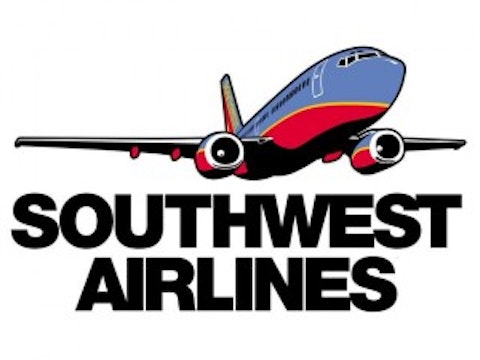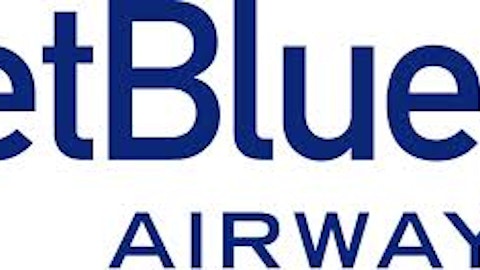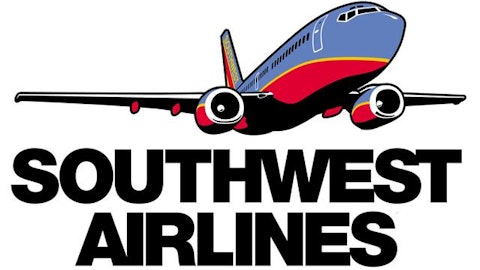
Industry Overview
The U.S. airline industry has been extremely competitive since it was deregulated in 1978. Due to intense competition, availability of substitutes for customers, low switching costs, and high supplier power, it is an extremely tough industry to operate in. As it is a low-margin industry, the airlines need to adopt innovative methods to continuously increase their efficiency in order to increase their margins. The industry has been going through a rough trend over the last few years. Projected trends in 2013 are also not very optimistic. Decline in flights, seat capacity and passengers are expected this year. Overall, the industry will see a 1.5-2% drop in traffic in 2013.
Southwest operational efficiency
Southwest Airlines Co. (NYSE:LUV) has been a successful low-cost airline in this intensely competitive industry. It has delivered forty years of consecutive earnings to its shareholders, even during the time when its competitors were filing for bankruptcy. The reasons behind this are the various steps it has undertaken to improve its operational efficiency. For example, it makes sure that its airplanes spend very little time on ground, and more in air. This is ensured by flying non-stop flights. It follows one-aircraft model, which helps it in reducing additional costs of training and maintenance. The company doesn’t operate in small cities, and therefore avoids unprofitable routes. It also suggests that the company focuses on economies of scale. These kinds of efforts bring operational efficiency and have generated profits for the airlines. Its profit margin is among the highest in the industry.
The airline has recently announced to expand to cities like Charlotte, Rochester, Flint, Portland, Maine, San Juan and Puerto Rico. It has plans to expand to high-traffic international markets as well, which will prove to be a growth catalyst in the time to come.

The above table is an indication of the fact that despite being one of the largest airlines in US, Southwest Airlines is less financially leveraged compared to its competitors. Its debt/equity ratio of 45.11 is less than all its peers. The equity is negative for Delta Airlines and AMR Corporation, therefore their debt/equity ratio is undefined. Even the liquidity ratio of the company is the highest among its other competitors. Its current ratio of 0.91 suggests that the company manages its current assets pretty well and therefore the company has enough liquidity to carry on the operations and pay off the interests for short and long term debts as well. This is further substantiated by the high operating cash flow for the company.
Acquisition
The process of integrating AirTran into the system is in progress and is expected to get completed by 2015. Though the investors have yet to see the payback from the acquisition, but there are natural synergies that emerge from the deal. It not only eliminates a major competitor, but also strengthens its position in the industry with respect to the other large airlines. It has given the company access to some international routes as well. It has also given the company an access to AirTran’s Hartsfield-Jackson Atlanta international airport, a location that has been on Southwest’s radar for years.
Competitors
Delta Air Lines, Inc. (NYSE:DAL), founded in 1924, operates in US and internationally through its fleet of approximately 700 aircraft. The stock is currently trading at a P/E multiple of 12.53 times on trailing basis, which is lower than the industry average. It has been on an upward trend and has given its investors a return of more than 50% since December 2012. The EPS growth forecast of the company is higher than the industry peers and therefore the stock is expected to move up more in the time to come.
JetBlue Airways Corporation (NASDAQ:JBLU), founded in 1998, operates in US, Mexico, Latin America and Caribbean through its fleet of 127 Airbus A320 aircraft and 53 EMBRAER 190 aircraft. Its stock has been quite volatile, but has followed an upward trend and has given its investors a return of more than 70% in the last year. It is currently trading at a P/E multiple of 17.9 times on trailing basis, which is higher than the industry average. The company has a very high debt/equity ratio, with comparatively lower liquidity ratio than its competitors. But as the EPS growth forecast for the next five years for the company is quite high, it seems to be a good investment for long term.
Conclusion
There are diverse opinions among the investors regarding the future price movement of the stock. While on one hand, Goldman Sachs reaffirmed their ‘neutral’ rating with a price target of $12.90, on the other hand, Deutsche Bank raised its price target to $15.00-$17.00. The consensus price target is $13.70.
There has always been optimism surrounding the company because of its profit generation ability that stems from its operational efficiency. It also has low debt in its balance sheet in this capital intensive industry, which further suggests a better fundamental forecast. Though the P/E ratio of the company is quite high at 22.62, which is higher than its competitors, but the robust growth forecast of the next five years makes this stock a good investment for long term.
The article This Airline Has Always Withstood Economic Storms Well originally appeared on Fool.com and is written by Sujata Dutta.
Copyright © 1995 – 2013 The Motley Fool, LLC. All rights reserved. The Motley Fool has a disclosure policy.



